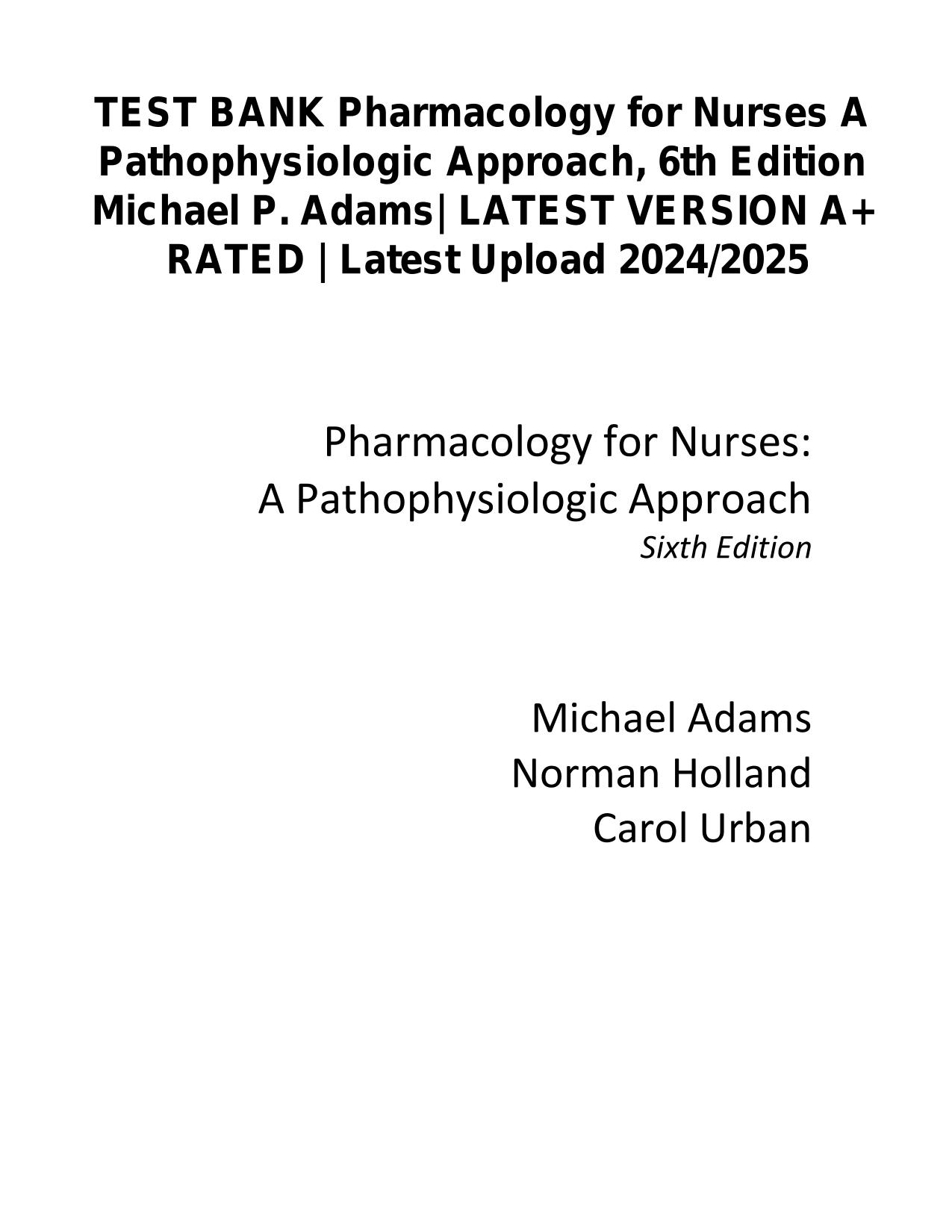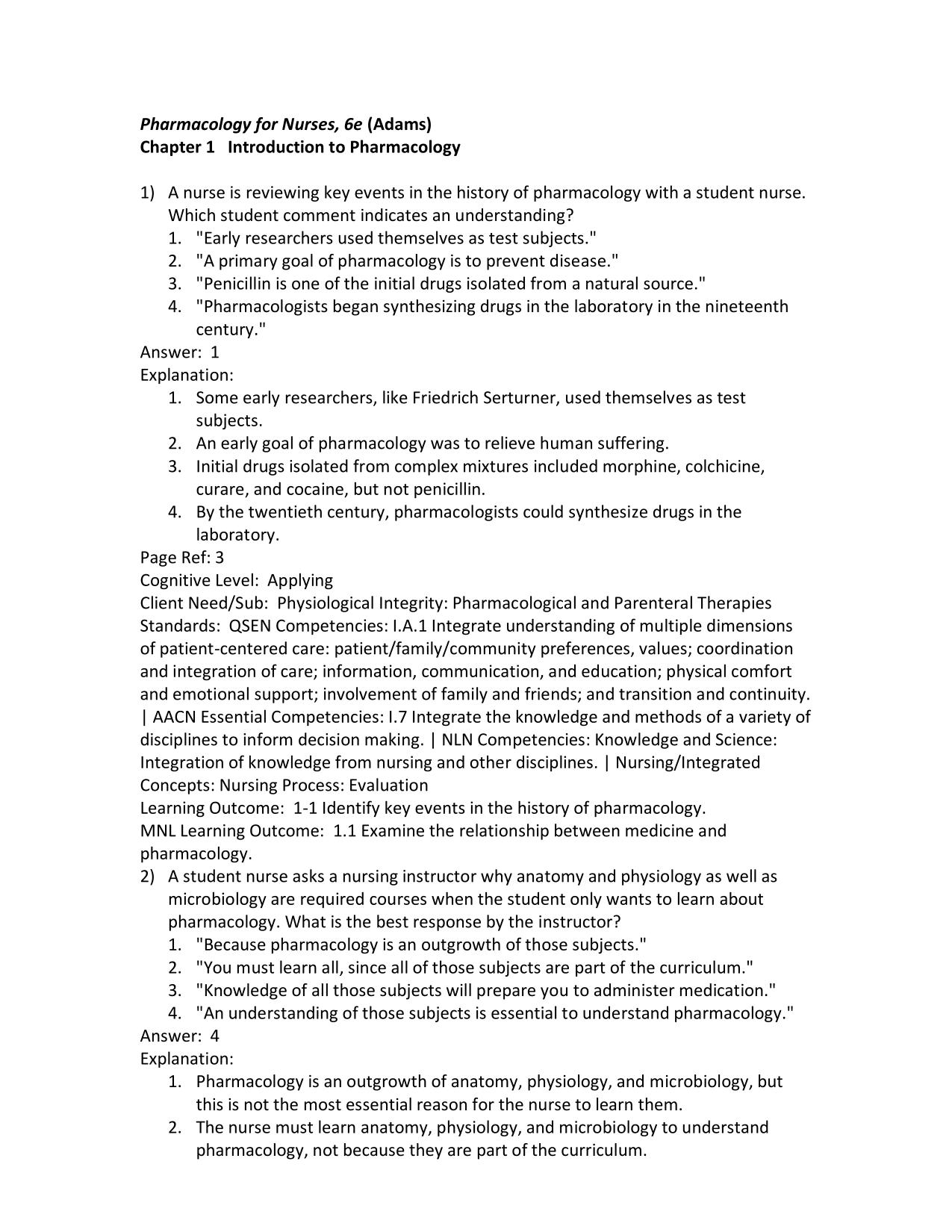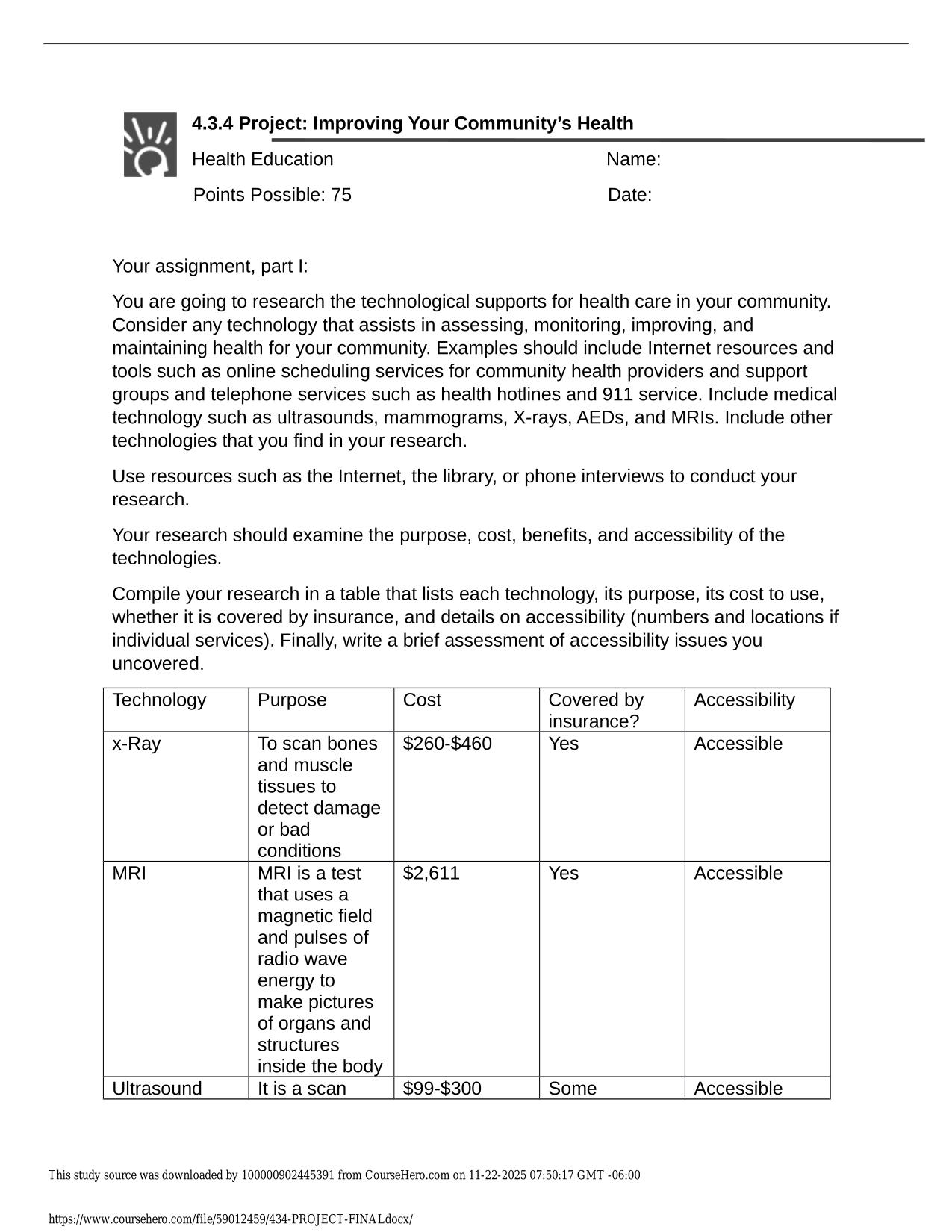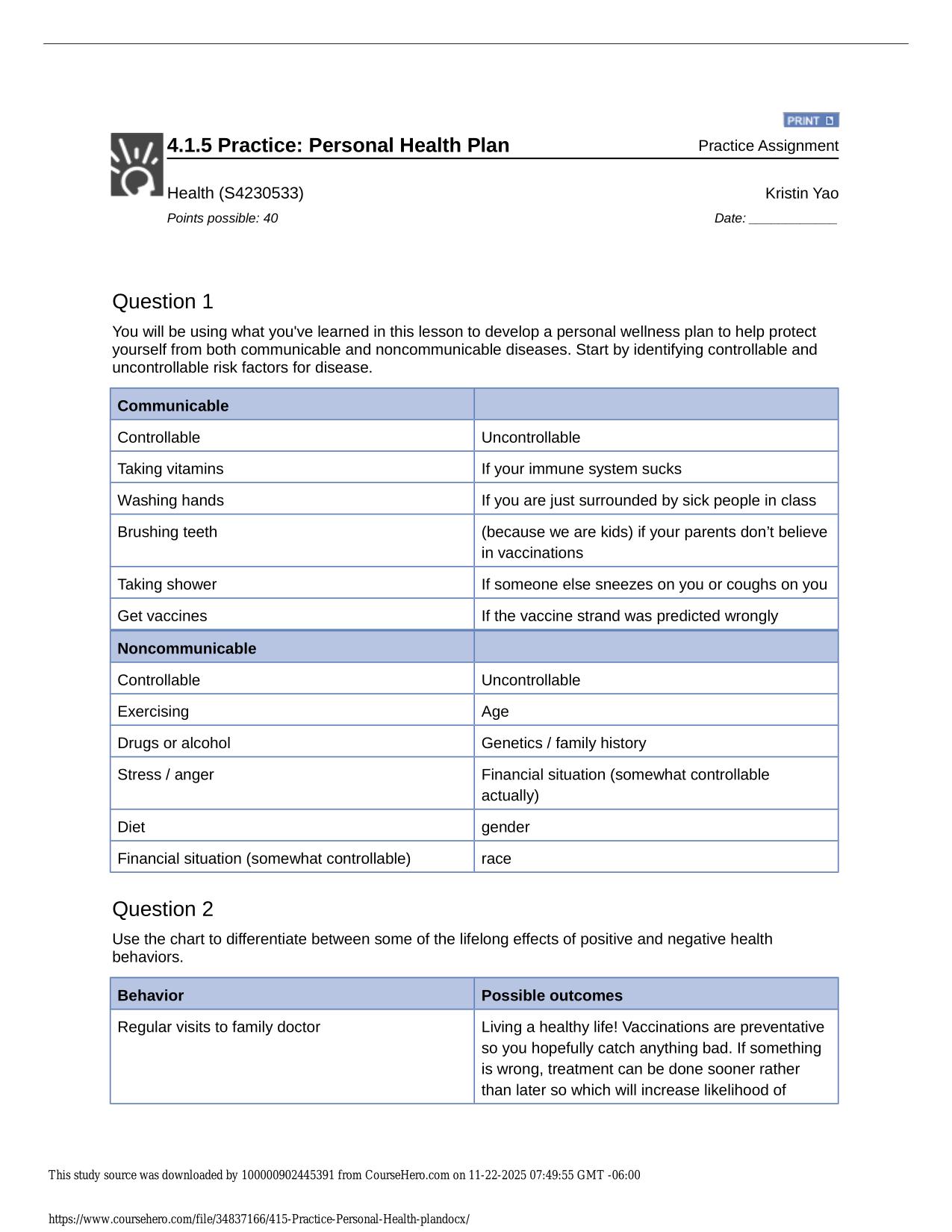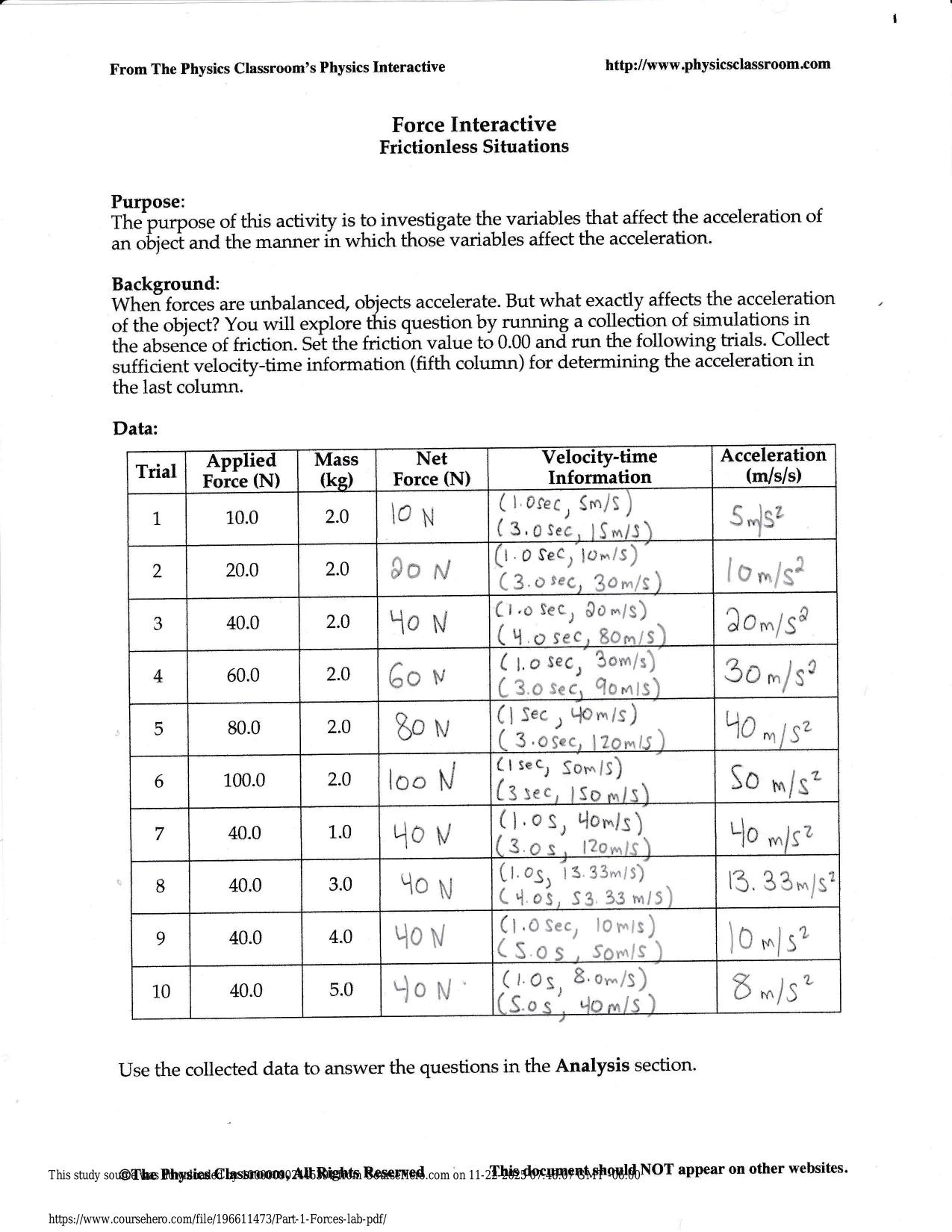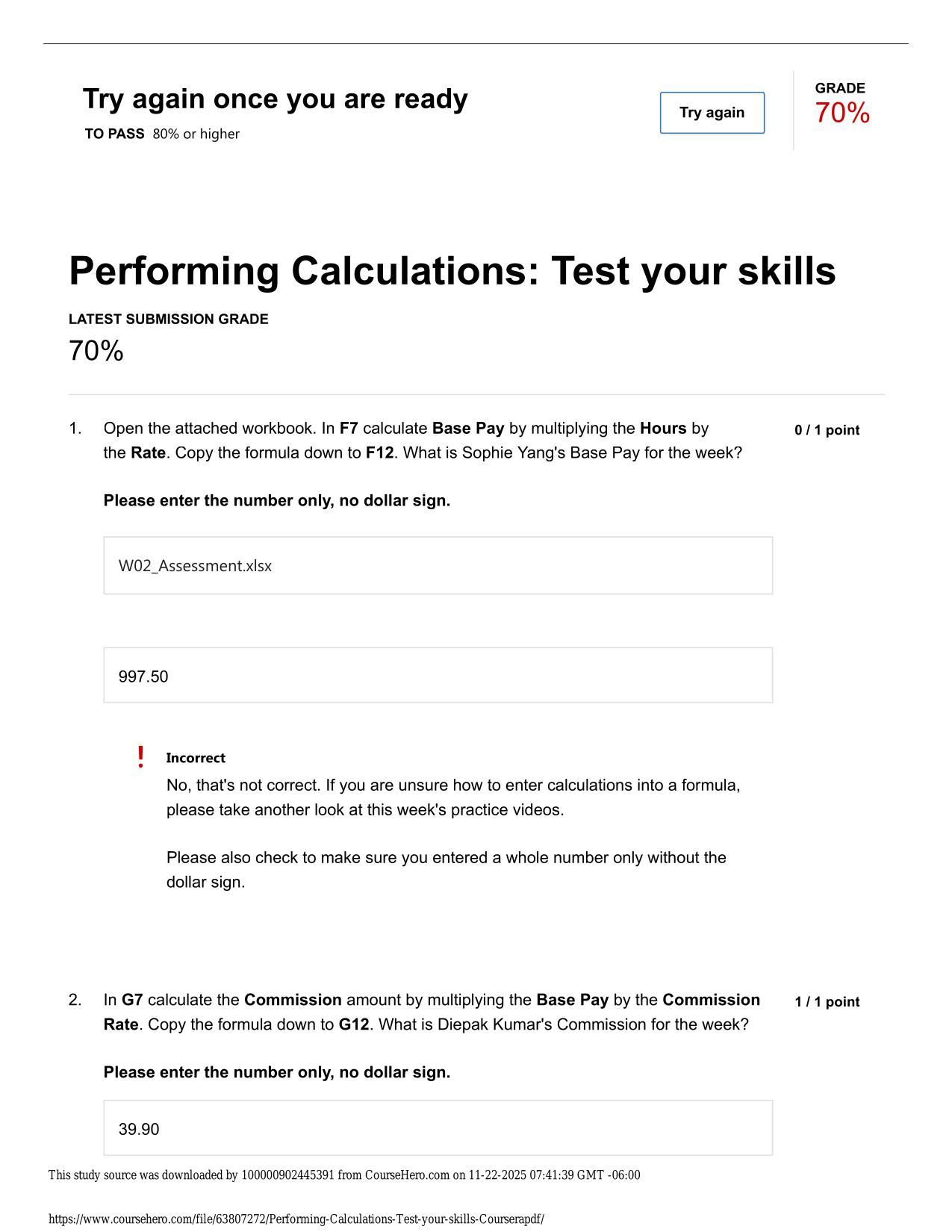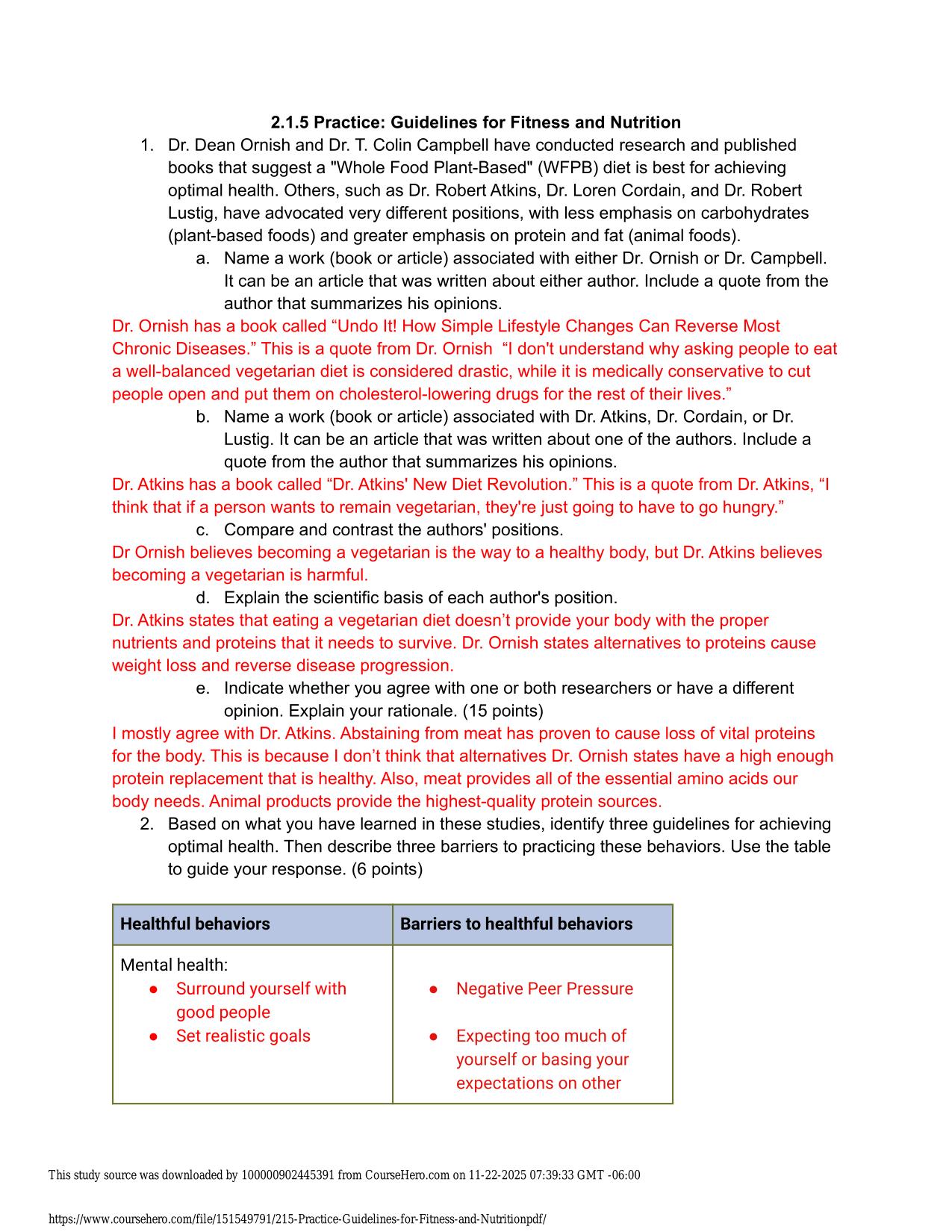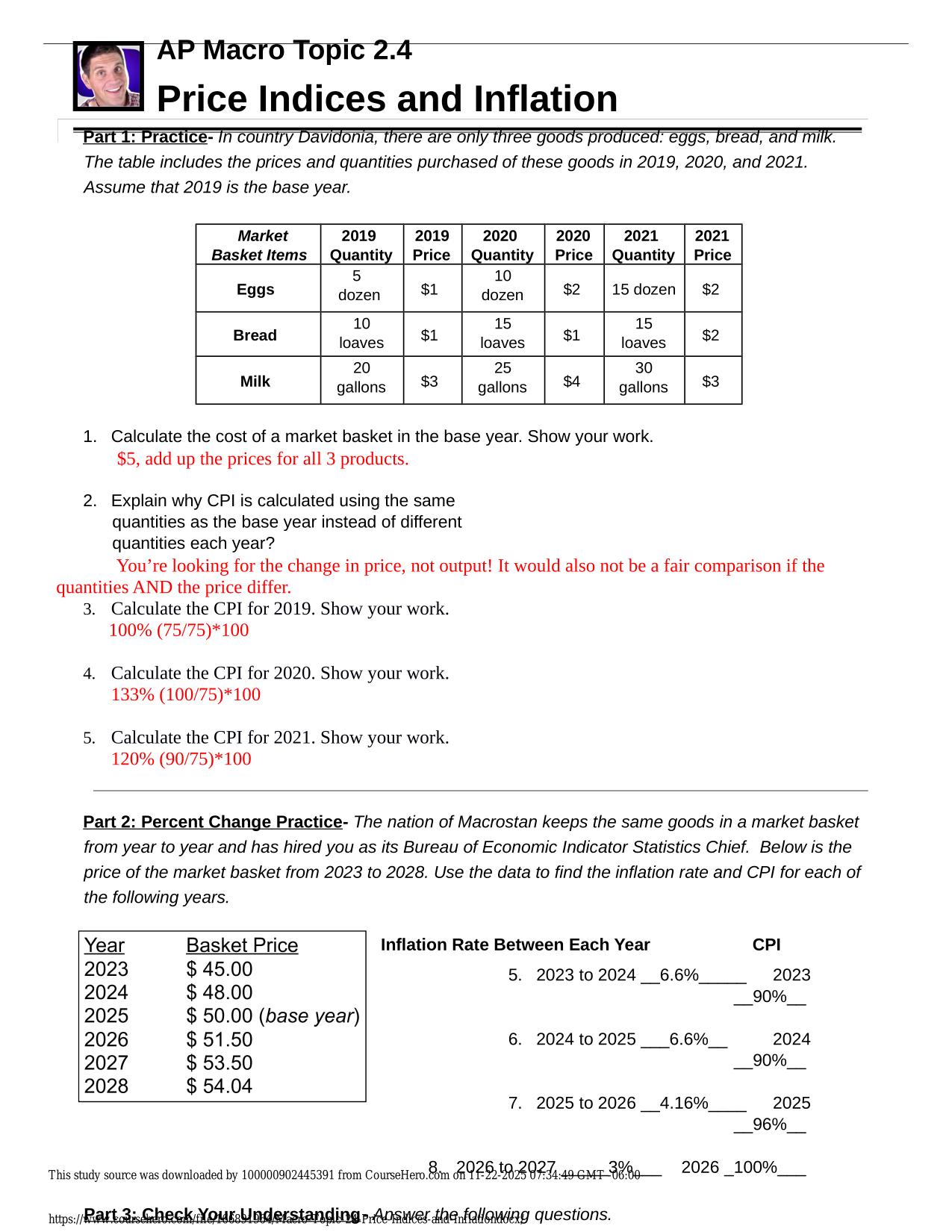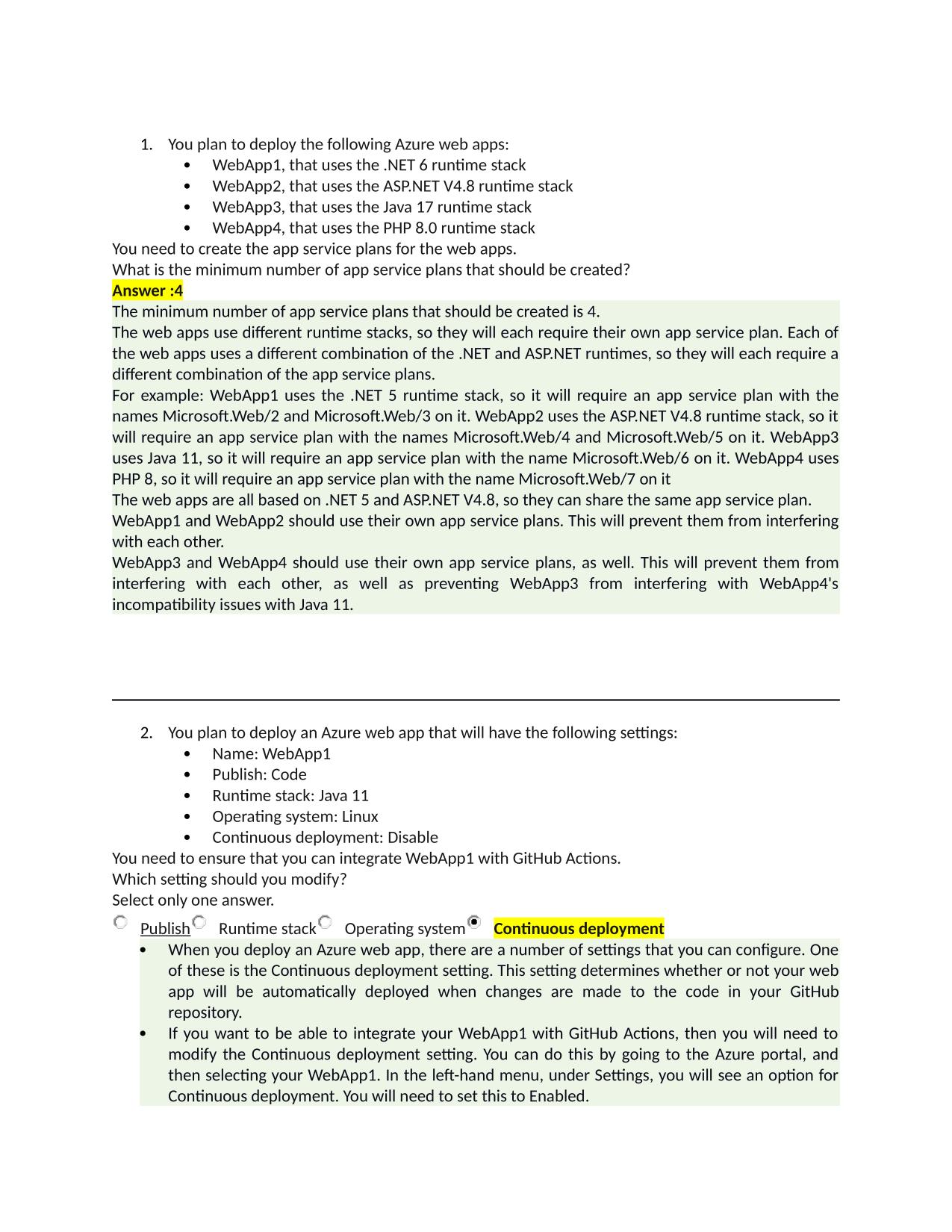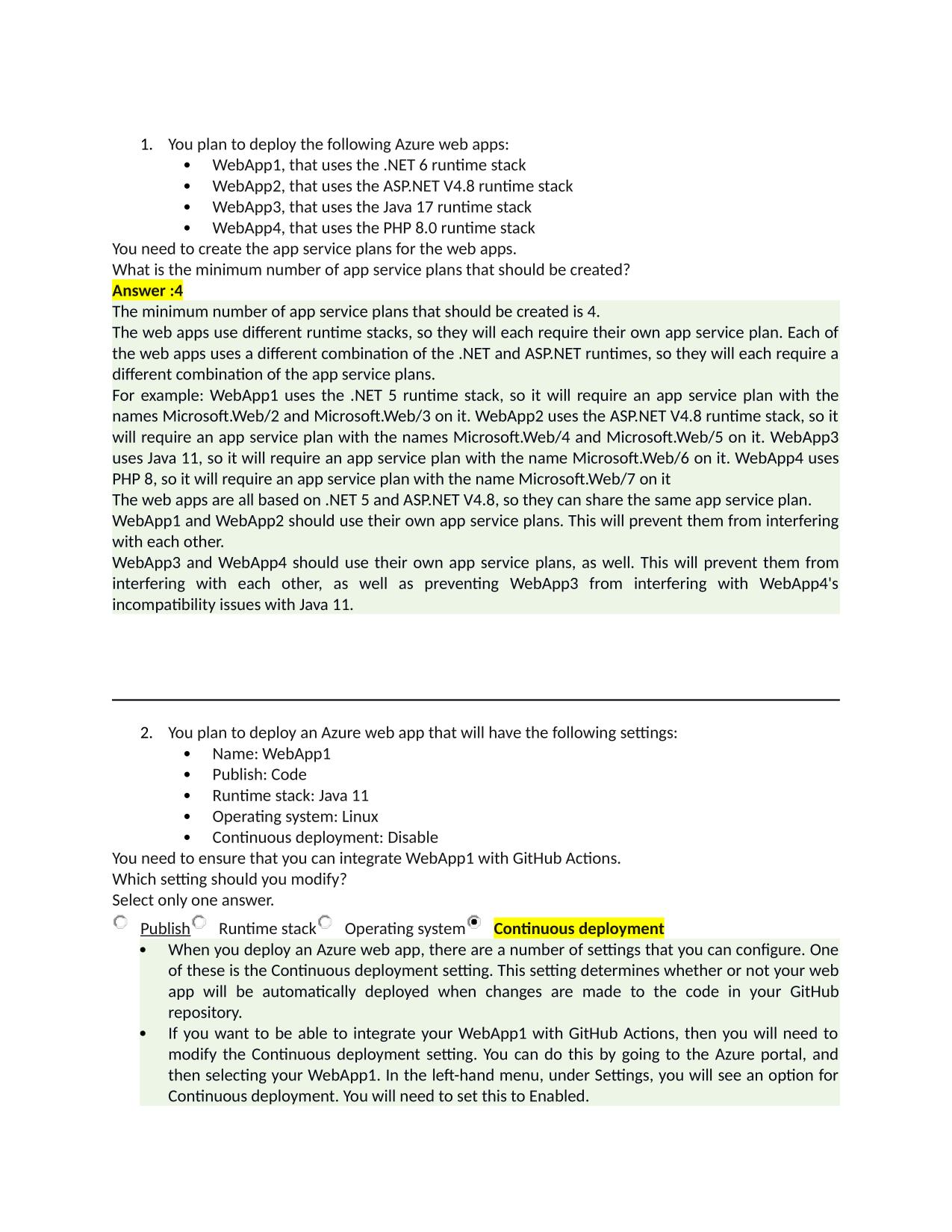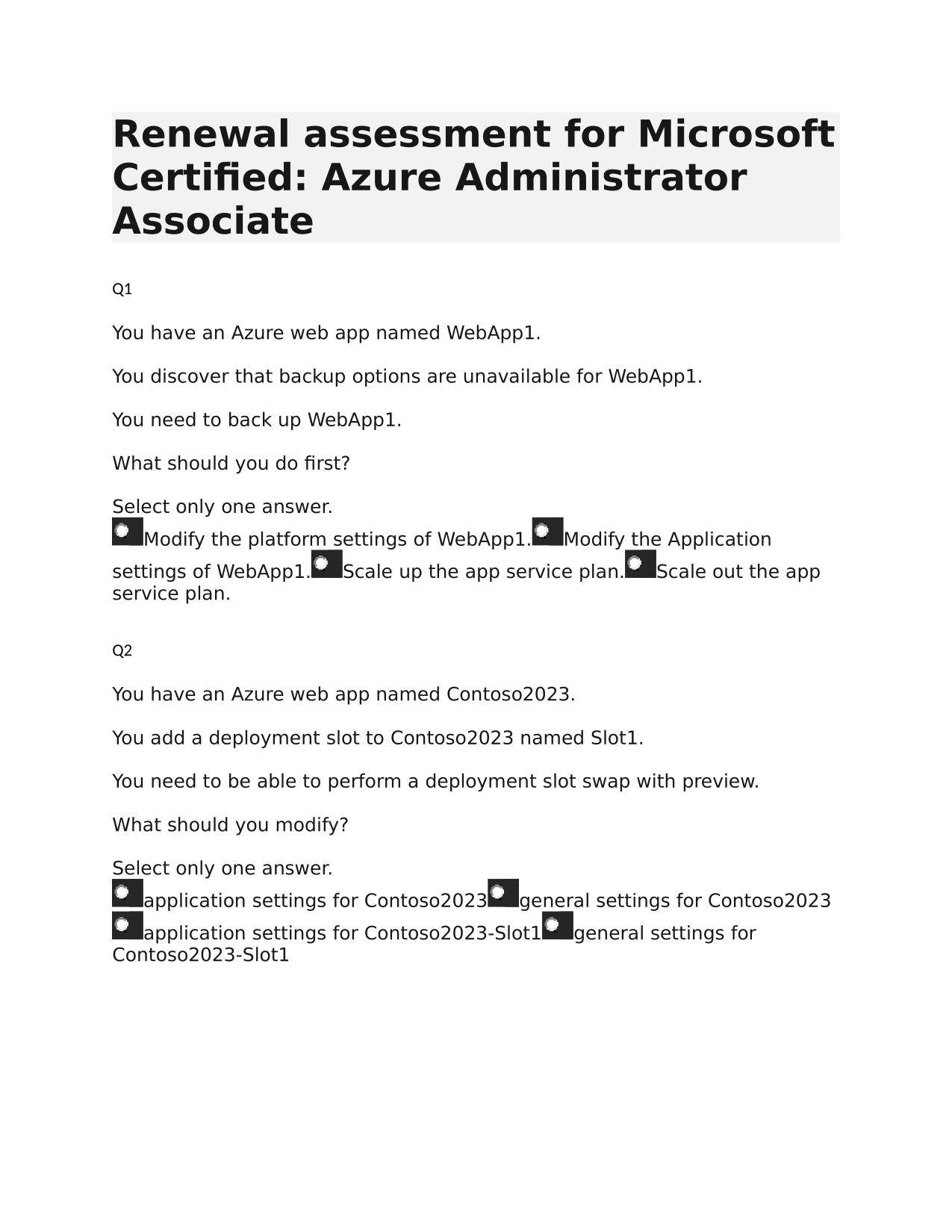TEST BANK Pharmacology for Nurses A Pathophysiologic Approach 6th Edition Michael P. Adams ISBN-10. 0135218330 Latest 2025
Course:
Pharmacology
Institution:
Pharmacology
TEST BANK Pharmacology for Nurses A Pathophysiologic Approach 6th Edition Michael P. Adams ISBN-10. 0135218330 Latest 2025 1) A nurse is reviewing key events in the history of pharmacology with a student nurse. Which student comment indicates an unde...
After purchase, you get:
✅ Instant PDF Download
✅ Verified answer explanations
✅ Refund if not Satisfied
✅ Prepared for 2025/2026 test cycle
Overview
This section strengthens analytical skills, helping users understand how exam questions are organized and graded. You'll develop insight into what examiners are looking for in complete, well-reasoned answers. This understanding helps you tailor your responses to meet scoring criteria more effectively. Many test-takers find this strategic awareness gives them an edge in maximizing their points on complex items.
Who Is This For?
Created for exam takers seeking maximum exposure to typical Testbank questions, rationales, and scenarios. People often use it to test their readiness before the actual exam. The complete coverage ensures thorough preparation. A strong fit for learners in Pharmacology looking to boost exam familiarity, question interpretation skills, and test-taking assurance. Students often share this resource with classmates during study groups. The practical approach has proven helpful across different learning styles.
Related Keywords
Detailed Study Description
Frequently Asked Questions
Document Information
| Uploaded on: | November 1, 2025 |
| Last updated: | November 17, 2025 |
| Number of pages: | 1454 |
| Written in: | 2025/2026 |
| Type: | Exam (elaborations) |
| Contains: | Questions & Answers |
| Tags: | TEST BANK Pharmacology for Nurses A Pathophysiologic Approach 6th Edition Michael P. Adams ISBN-10. 0135218330 Latest 2025 1) A nurse is reviewing key events in the history of pharmacology with a student nurse. Which student comment indicates an understanding? 1. "Early researchers used themselves as test subjects." 2. "A primary goal of pharmacology is to prevent disease." 3. "Penicillin is one of the initial drugs isolated from a natural source." 4. "Pharmacologists began synthesizing drugs in the laboratory in the nineteenth century." Answer: 1 Explanation: 1. Some early researchers, like Friedrich Serturner, used themselves as test subjects. 2. An early goal of pharmacology was to relieve human suffering. 3. Initial drugs isolated from complex mixtures included morphine, colchicine, curare, and cocaine, but not penicillin. 4. By the twentieth century, pharmacologists could synthesize drugs in the laboratory. Page Ref: 3 Cognitive Level: Applying Client Need/Sub: Physiological Integrity: Pharmacological and Parenteral Therapies Standards: QSEN Competencies: I.A.1 Integrate understanding of multiple dimensions of patient-centered care: patient/family/community preferences, values; coordination and integration of care; information, communication, and education; physical comfort and emotional support; involvement of family and friends; and transition and continuity. | AACN Essential Competencies: I.7 Integrate the knowledge and methods of a variety of disciplines to inform decision making. | NLN Competencies: Knowledge and Science: Integration of knowledge from nursing and other disciplines. | Nursing/Integrated Concepts: Nursing Process: Evaluation Learning Outcome: 1-1 Identify key events in the history of pharmacology. MNL Learning Outcome: 1.1 Examine the relationship between medicine and pharmacology. 2) A student nurse asks a nursing instructor why anatomy and physiology as well as microbiology are required courses when the student only wants to learn about pharmacology. What is the best response by the instructor? 1. "Because pharmacology is an outgrowth of those subjects." 2. "You must learn all, since all of those subjects are part of the curriculum." 3. "Knowledge of all those subjects will prepare you to administer medication." 4. "An understanding of those subjects is essent |
Seller Information

AdelineJean
User Reviews (0)
Exam (Elaborations)
$18.00
Add to Cart
100% satisfaction guarantee
Refund Upon dissatisfaction
Immediately available after purchase
Available in Both online and PDF
$18.00
| 0 sold
Discover More resources
Inside The Document
TEST BANK Pharmacology for Nurses A Pathophysiologic Approach, 6th Edition Michael P. Adams| LATEST VERSION A+ RATED | Latest Upload 2024/2025 Pharmacology for Nurses: A Pathophysiologic Approach Sixth Edition Michael Adams Norman Holland Carol Urban Pharmacology for Nurses, 6e (Adams) Chapter 1 Introduction to Pharmacology 1) A nurse is reviewing key events in the history of pharmacology with a student nurse. Which student comment indicates an understanding? 1. "Early researchers used themselves as test subjects." 2. "A primary goal of pharmacology is to prevent disease." 3. "Penicillin is one of the initial drugs isolated from a natural source." 4. "Pharmacologists began synthesizing drugs in the laboratory in the nineteenth century." Answer: 1 Explanation: 1. Some early researchers, like Friedrich Serturner, used themselves as test subjects. 2. An early goal of pharmacology was to relieve human suffering. 3. Initial drugs isolated from complex mixtures included morphine, colchicine, curare, and cocaine, but not penicillin. 4. By the twentieth century, pharmacologists could synthesize drugs in the laboratory. Page Ref: 3 Cognitive Level: Applying Client Need/Sub: Physiological Integrity: Pharmacological and Parenteral Therapies Standards: QSEN Competencies: I.A.1 Integrate understanding of multiple dimensions of patient-centered care: patient/family/community preferences, values; coordination and integration of care; information, communication, and education; physical comfort and emotional support; involvement of family and friends; and transition and continuity. | AACN Essential Competencies: I.7 Integrate the knowledge and methods of a variety of disciplines to inform decision making. | NLN Competencies: Knowledge and Science: Integration of knowledge from nursing and other disciplines. | Nursing/Integrated Concepts: Nursing Process: Evaluation Learning Outcome: 1-1 Identify key events in the history of pharmacology. MNL Learning Outcome: 1.1 Examine the relationship between medicine and pharmacology. 2) A student nurse asks a nursing instructor why anatomy and physiology as well as microbiology are required courses when the student only wants to learn about pharmacology. What is the best response by the instructor? 1. "Because pharmacology is an outgrowth of those subjects." 2. "You must learn all, since all of those subjects are part of the curriculum." 3. "Knowledge of all those subjects will prepare you to administer medication." 4. "An understanding of those subjects is essential to understand pharmacology." Answer: 4 Explanation: 1. Pharmacology is an outgrowth of anatomy, physiology, and microbiology, but this is not the most essential reason for the nurse to learn them. 2. The nurse must learn anatomy, physiology, and microbiology to understand pharmacology, not because they are part of the curriculum. 3. Knowledge of anatomy, physiology, and microbiology prepares the nurse to understand pharmacology, not to provide care such as administration of medications. 4. It is essential for the nurse to have a broad knowledge base of many sciences in order to learn pharmacology. Page Ref: 3 Cognitive Level: Applying Client Need/Sub: Physiological Integrity: Pharmacological and Parenteral Therapies Standards: QSEN Competencies: I.A.1 Integrate understanding of multiple dimensions of patient-centered care: patient/family/community preferences, values; coordination and integration of care; information, communication, and education; physical comfort and emotional support; involvement of family and friends; and transition and continuity. | AACN Essential Competencies: I.7 Integrate the knowledge and methods of a variety of disciplines to inform decision making. | NLN Competencies: Knowledge and Science: Integration of knowledge from nursing and other disciplines. | Nursing/Integrated Concepts: Nursing Process: Implementation Learning Outcome: 1-2 Explain the interdisciplinary nature of pharmacology, giving an example of how knowledge from different sciences impacts the nurse's role in drug administration. MNL Learning Outcome: 1.1 Examine the relationship between medicine and pharmacology. 3) A nurse is teaching a group of nurses about the differences between pharmacology and therapeutics. The nurse determines that learning has occurred when which statements are made? Note: Credit will be given only if all correct choices and no incorrect choices are selected. Select all that apply. 1. "Pharmacology is the development of medicines." 2. "Pharmacology is the study of medicines." 3. "Therapeutics relates to drug use to treat suffering." 4. "Therapeutics is the study of drug interactions." 5. "Pharmacology is the study of drugs to prevent disease." Answer: 2, 3, 5 Explanation: 1. Pharmacology is not the development of medicines. 2. Pharmacology is the study of medicines. 3. Therapeutics is the use of drugs in the treatment of suffering. 4. Therapeutics is not related to study of drug interactions. 5. Pharmacotherapy is the application of drugs for the purpose of disease prevention. Page Ref: 4 Cognitive Level: Applying Client Need/Sub: Physiological Integrity: Pharmacological and Parenteral Therapies Standards: QSEN Competencies: I.A.1 Integrate understanding of multiple dimensions of patient-centered care: patient/family/community preferences, values; coordination and integration of care; information, communication, and education; physical comfort and emotional support; involvement of family and friends; and transition and continuity. | AACN Essential Competencies: I.7 Integrate the knowledge and methods of a variety of disciplines to inform decision making. | NLN Competencies: Knowledge and Science: Integration of knowledge from nursing and other disciplines. | Nursing/Integrated Concepts: Nursing Process: Evaluation Learning Outcome: 1-3 Compare and contrast therapeutics and pharmacology. MNL Learning Outcome: 1.1 Examine the relationship between medicine and pharmacology. 4) A nurse administers a vaccine to a client. What is the nurse's best understanding as it relates to the manufacture of a vaccine? 1. The vaccine is produced by natural plant extracts in the laboratory. 2. The vaccine is naturally produced in animal cells or microorganisms. 3. The vaccine is produced by a combination of animal and plant products. 4. The vaccine is most commonly synthesized in a laboratory. Answer: 2 Explanation: 1. Vaccines are not produced by natural plant extracts. 2. Vaccines are naturally produced in animal cells, microorganisms, or by the body itself. 3. Vaccines are not produced by a combination of animal and plant products. 4. Vaccines are not synthesized in a laboratory. Page Ref: 4 Cognitive Level: Applying Client Need/Sub: Physiological Integrity: Pharmacological and Parenteral Therapies Standards: QSEN Competencies: III.A.1 Demonstrate knowledge of basic scientific methods and processes. | AACN Essential Competencies: IX.3 Implement holistic, patient-centered care that reflects an understanding of human growth and development, pathophysiology, pharmacology, medical management, and nursing management across the health-illness continuum, across lifespan, and in all healthcare settings. | NLN Competencies: Knowledge and Science: Integration of knowledge from nursing and other disciplines. | Nursing/Integrated Concepts: Nursing Process: Evaluation Learning Outcome: 1-4 Compare and contrast traditional drugs, biologics, and complementary and alternative medicine therapies. MNL Learning Outcome: 1.1 Examine the relationship between medicine and pharmacology. 5) An older client is admitted with gastrointestinal bleeding. The client says to the nurse, "I don't understand this. All I did was take ibuprofen (Advil) for my arthritis." What is the nurse's best response? 1. Review nonpharmacologic methods to relieve joint pain. 2. Encourage the client to substitute safer drugs, such as acetaminophen (Tylenol). 3. Remind the client to contact their healthcare provider before taking any overthe-counter (OTC) medications. 4. Teach the client about the side effects of ibuprofen (Advil). Answer: 4 Explanation:
CourseHero & Studypool Unlocks
Get Unlocked CourseHero and Studypool documents files instantly to your email, simply by pasting your link and clicking "Unlock Now". Learn more on how to unlock here.
